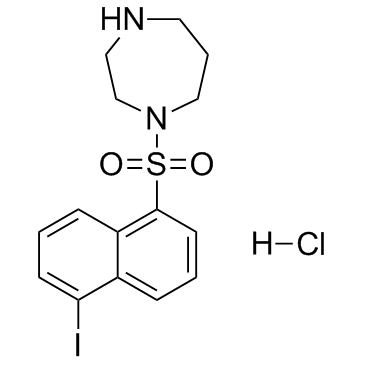All AbMole products are for research use only, cannot be used for human consumption.

In vitro: ML-7 hydrochloride inhibits rabbit portal vein α1-adrenoceptor NSCC with IC50 of 0.8 μM. The myosin light chain kinase (MLCK) inhibitor ML-7 hydrochloride (3 μ M and 10 μM) also attenuates the Dexmedetomidine (DMT)-induced contraction (p<0.05 versus control).
In vivo: In sham operated animals Evans Blue extravasation is not different between ML-7 hydrochloride and vehicle group (sham+vehicle: 0.26±0.02 OD/g; sham+ML-7: 0.26±0.02 OD/g). After CCI inhibition of MLCK with ML-7 results in a significant lower amount of intracerebral Evans Blue compared to vehicle treated animals (CCI+vehicle: 0.42±0.04 OD/g; CCI+ML-7: 0.35±0.05 OD/g, p=0.048)

Vet Microbiol. 2025 Mar 26;304:110494.
JEV NS1'protein enhances cell-to-cell viral spread by inducing the formation of tunneling nanotubes
ML-7 hydrochloride purchased from AbMole
| Cell Experiment | |
|---|---|
| Cell lines | MCF-10A cells, MDCK cells |
| Preparation method | Cells are treated with vehicle alone, Blebbistatin, ML-7, ML-9, latrunculin A or Y-27632 in media without serum at varying concentrations and time points before being fixed or prepared for FACS analysis. Untreated cells are also serum starved for the duration of the inhibitor treatment. Stock solutions of each agent are made in DMSO (50 μM Blebbistatin, 5 mM LA), 50% ethanol (10 mM ML-7), 70% ethanol (20 mM ML-9) or water (20 mM Y-27632) and are maintained at -20°C. |
| Concentrations | 40 μM |
| Incubation time | 16 h |
| Animal Experiment | |
|---|---|
| Animal models | Mice |
| Formulation | distilled water |
| Dosages | 1 mg/kg |
| Administration | i.p. |
| Molecular Weight | 452.74 |
| Formula | C15H18ClIN2O2S |
| CAS Number | 110448-33-4 |
| Solubility (25°C) | DMSO 40 mg/mL Water 1 mg/mL (ultrasonic) |
| Storage |
Powder -20°C 3 years ; 4°C 2 years In solvent -80°C 6 months ; -20°C 1 month |
| Related Products |
|---|
| DSPE-PEG-FA
DSPE-PEG2K-FA is a PEG derivative containing folic acid. DSPE-PEG2K-FA has a targeting effect and can bind to folic acid receptors in cancer cells. DSPE-PEG2K-FA forms micelles/lipid bilayers and can be used in research on targeted drug delivery systems. |
| Lifastuzumab
Lifastuzumab is a humanized anti-NaPi2b IgG1 monoclonal antibody. |
| GPVI antagonist 1
GPVI antagonist 1 is a glycoprotein VI (GPVI) platelet receptor antagonist. GPVI antagonist 1 inhibits collagen-induced platelet aggregation with an IC50 of 25.3 μM. |
| MPSD TFA
MPSD TFA (MARCKS-ED TFA) is a 25-amino acid peptide based on the effector domain sequence of the intracellular membrane protein myristoylated alanine-rich C-kinase substrate (MARCKS). MPSD TFA can sense membrane curvature and recognize phosphatidylserine. MPSD TFA can be utilized as biological probe to study membrane shape and lipid composition. |
| 4-Nitro-2,1,3-benzoselenadiazole
4-Nitro-2,1,3-benzoselenadiazole is a biochemical material that can be used in scientific research. |
All AbMole products are for research use only, cannot be used for human consumption or veterinary use. We do not provide products or services to individuals. Please comply with the intended use and do not use AbMole products for any other purpose.


Products are for research use only. Not for human use. We do not sell to patients.
© Copyright 2010-2024 AbMole BioScience. All Rights Reserved.
